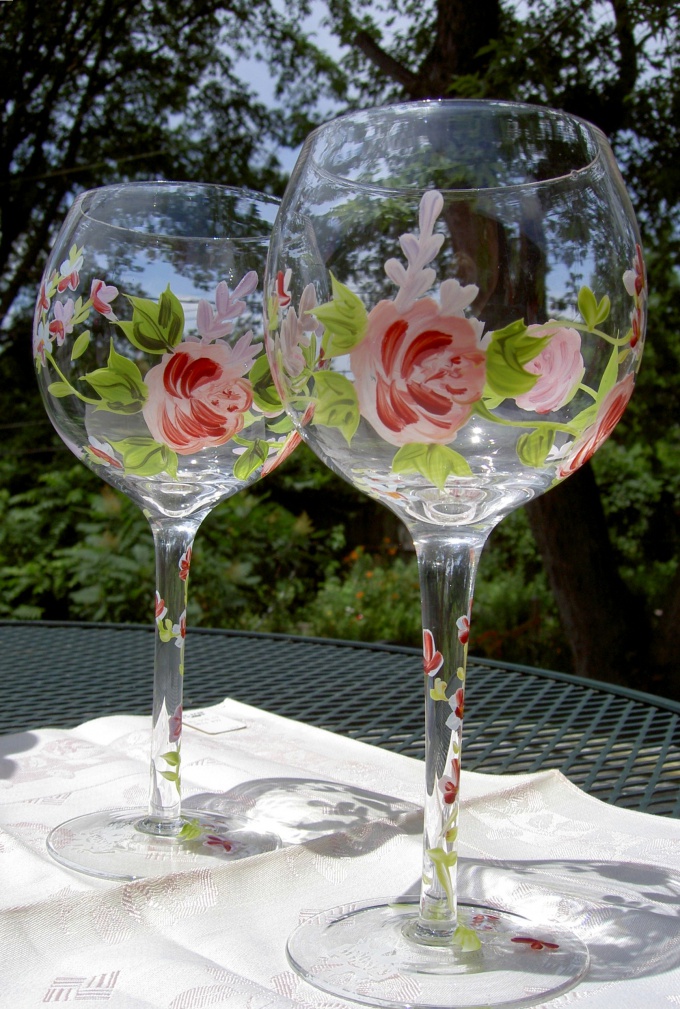You will need
- Embossed stamps;
- - synthetic brush;
- the contours on the glass;
- - acrylic paint;
- - palette;
- - acrylic lacquer;
- - solvent;
- - cotton pads.
Instruction
1
First you need to choose a figure for use on glass. Of course, you can come up with the figure during painting, but to draw well can not all. For such cases there are special embossed stamps, a pattern which can be transferred to the glass. Can be done differently. Select the picture (on the Internet), treat it so that there is only the outline, print it and attach to the glass from the side opposite the one on which you will draw. Then lightly moisten the paper so it stuck to the glass. You can start painting. Don't forget to paint the surface of pre-wipe with alcohol to remove skin oils and other contaminants.
2
The pattern on the glass can be applied using special outlines or without them. The footprints on the glass like paint, available in different colors, usually packaged in tubes and are used to create the painting on glass in a stained glass technique. Thicker than paint, the contours prevent the mixing and spreading of the acrylic, however it is rather difficult to apply, and we cannot do without training. Contour should be applied, lightly squeezing the tube and quickly moving it to the "nose" on the surface in the direction you want. Speed and pressure should be the same all over the reference line, or you will get an uneven outline. Small irregularities can be corrected using a cotton Bud soaked in water.
3
Then take a synthetic brush in a cone shape. The finer details of the image that you want to paint, the thinner should be the brush. Apply the pattern on the glass is possible by two main techniques. The first technique is more suitable for the transparent (stained) colors, opaque acrylic paint can also be applied in this way. Acrylic paint to lay down smooth dial on the tassel more colors and slightly touching the glass, pull the paint little by little to the sides, evenly distributing it over the surface is not too thin. Once the paint ceases to drain freely from the brush, swirl it again. Do this often and quickly, not to allow to dry dyed edges of the space, otherwise you will get ugly divorces. The brush should not double-tap the same place, acrylic paints are applied in this technique only one time.
4
If you are going to do painting on glass alkyd paints, the application technique will be the same. Note that acrylic paints are based on alkyd resins, unlike water based paints, better spread, and do not require baking, but have a pungent smell and are washed away by the solvent. The second application technique similar to conventional drawing on paper. To perform the painting on glass in this technique you will need an opaque acrylic paint. Usually in this technique to paint flowers. It made broad strokes. This technique could be applied in one coat of paint on top of the other, but the first layer needs time to dry.
5
After you apply the pattern on the glass, let it dry. Full drying time is usually specified in the instructions to the paint. The majority of acrylic water based paints require baking. Bake ware, painted with acrylic paints, water-based, can be in the oven at the temperature specified in the instructions. The finishing touch, which will enhance the results of your work, this coating is acrylic lacquer. Cover with acrylic lacquer, it is desirable and items painted with alkyd paints, and products decorated with water based paints.
6
A few small secrets. If you want to give texture to a drawing, take a hard brush. It will leave grooves, which when dry will make the surface uneven. You can use the and sponge. Dipping the sponge in paint, tapping motion, apply the paint to the surface. If you don't have the right color, you can try to get it, mixing between the existing shades. If you need to paint a large surface (to make background), use a spray acrylic paint.
Note
When using acrylic paints based on alkyd resins often ventilate the room, to rid of the strong smell. Do not be amiss to use a respirator.
Useful advice
After work, be sure to wash the brushes that were used in the process of painting on glass. If you used paint is water based, it can be washed off with plain water. Most importantly, do not let them dry out. Paints based on alkyd resins and acrylic lacquer can be washed off only with a special solvent. For this dip a cotton pad in the solvent and carefully wipe the brush. Solvent residue from the brushes can be washed off with soap and water.
